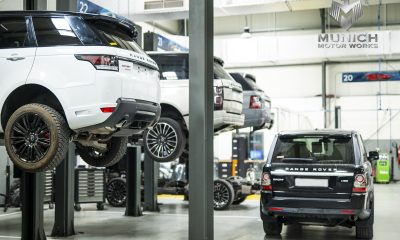Insurance
Why So Many People Rent a Car Monthly in Dubai

Dubai, a bustling metropolis known for its luxury and extravagance, is a city where transportation is crucial. Whether you’re a resident or a visitor, navigating Dubai’s expansive landscape efficiently is essential. One question that often arises is whether it’s financially prudent to rent a car Dubai for a month rather than purchasing one outright. Let’s delve into this topic and uncover the factors at play.
Cost Comparison: Renting vs. Buying
Purchasing a car entails significant upfront costs, including down payments, registration fees, and insurance premiums. On the contrary, renting a car on a monthly basis offers a more manageable financial commitment, typically involving a fixed monthly rental fee without the burden of ownership costs.

Flexibility and Convenience
Monthly car rentals in Dubai provide unparalleled flexibility and convenience. With a rental, you can choose from a diverse range of vehicles to suit your needs, without worrying about depreciation or maintenance expenses. Additionally, most rental agreements include comprehensive insurance coverage, further enhancing peace of mind.
Hidden Costs in Car Ownership
Owning a car comes with a myriad of hidden costs, such as routine vehicle maintenance, repairs, and insurance premiums. By opting for a monthly rental, you bypass these additional expenses, allowing for better budget management and cost savings in the long run.
Factors Influencing Rental Costs
The cost of monthly car rentals in Dubai varies depending on several factors, including the type of vehicle, rental duration, and insurance options. Luxury cars may command higher rental fees, while longer rental periods often come with discounted rates.
Economic Viability for Different Scenarios
For short-term visitors or expatriates, renting a car on a monthly basis may prove more economical than purchasing one outright. Conversely, long-term residents may benefit from owning a vehicle, provided they can absorb the initial costs and ongoing expenses.
Quality of Life Benefits
Beyond the financial aspect, monthly car rentals offer intangible benefits such as convenience and peace of mind. With a rental vehicle at your disposal, you can explore Dubai’s attractions at your leisure, without being tethered to public transportation schedules.

Considerations for Tourists and Expatriates
Tourists and expatriates often find monthly car rentals in Dubai to be a practical solution for their transportation needs. Rental agencies cater to temporary residents by offering flexible terms and hassle-free services, making it an attractive option for those in transit.
Environmental Impact
From an environmental standpoint, monthly car rentals contribute to sustainability by promoting resource-sharing and reducing carbon emissions. By utilizing shared vehicles instead of owning individual cars, residents can minimize their ecological footprint and support eco-friendly initiatives.
Insurance and Liability
When renting a car on a monthly basis, it’s essential to understand the insurance coverage and liability implications. Most rental agreements include basic insurance provisions, but renters may opt for additional coverage for added protection in case of accidents or damages.
Availability and Accessibility
Dubai boasts a plethora of rental agencies, ensuring accessibility and availability for potential renters. Whether you prefer mainstream agencies or boutique providers, you’ll find a myriad of options to choose from, each offering unique benefits and services.
Customer Reviews and Satisfaction
Before committing to a monthly car rental, it’s prudent to research customer reviews and satisfaction rates. By gauging the experiences of past renters, you can gain valuable insights into the reliability and professionalism of different rental agencies.

Smart Tips for Renting a Car in Dubai
To maximize the benefits of monthly car rentals in Dubai, consider the following tips:
- Negotiate rental rates based on the duration of your stay.
- Review the rental agreement thoroughly to avoid any hidden fees or penalties.
- Choose a vehicle that aligns with your needs and preferences.
- Familiarize yourself with Dubai’s traffic rules and regulations to avoid fines and violations.
Conclusion
In conclusion, renting a car on a monthly basis in Dubai offers a cost-effective and convenient transportation solution for residents and visitors alike. By bypassing the financial burdens and logistical complexities of car ownership, renters can enjoy unparalleled flexibility and freedom while exploring everything that Dubai has to offer.
Top 5 FAQs
1. Are there any mileage restrictions with monthly car rentals?
Most rental agreements include unlimited mileage, but it’s essential to confirm this with the rental agency beforehand.
2. Can I rent a luxury car on a monthly basis?
Yes, many rental agencies in Dubai offer luxury car rentals on a monthly basis, catering to clients’ discerning tastes and preferences.
3. Is there a minimum age requirement for renting a car monthly in Dubai?
Yes, renters must typically be at least 21 years old to rent a car in Dubai, although some agencies may impose higher age requirements for certain vehicle categories.
4. How do I handle traffic fines and parking violations while renting a car?
Renters are responsible for any traffic fines or parking violations incurred during the rental period. It’s essential to settle these promptly to avoid penalties.
5. Are there any additional charges for returning the car early?
Some rental agencies may impose early return fees if you terminate the rental agreement before the agreed-upon period. It’s advisable to clarify this with the agency in advance to avoid surprises.
Insurance
What to Expect When You Are Planning on Getting a Car Among Used Cars in Chandler?

It can be useful and save you money to buy a used car, especially in Chandler, Arizona, where the market is very competitive. Chandler has a lot of trustworthy shops and private sellers who sell a wide range of employed cars. These tips will help you make an informed and sure choice when looking at used cars in Chandler.
#1. A Wide Range of Options
Chandler has an amazing assortment of used automobiles, from affordable sedans and dependable SUVs to tough trucks and opulent models. AutoMart Chandler and other dealers with a wide range of cars often have approved pre-owned vehicles that come with warranties and have been through thorough inspections. As a result, buyers will always be able to find high-quality cars that meet their needs and preferences.
#2. Vehicle History Report
An automobile history report is crucial. This report includes ownership, accidents, servicing, and salvage/rebuilt status. AutoCheck and Carfax provide thorough car history, condition, and reliability data.
#3. Mileage Considerations
Mileage significantly impacts a used car’s value and potential longevity. Lower mileage generally indicates less wear and tear, but it’s vital to balance mileage with the car’s age and maintenance history. A well-maintained high-mileage car can sometimes be a better choice than a low-mileage vehicle that hasn’t been properly cared for.
#4. Certified Pre-Owned Programs
CPO cars are a compromise between new and used. CPO automobiles are newer, low-mileage models with extended warranties and rigorous inspections. Many dealerships in Chandler are part of CPO programs backed by the maker, which gives customers more peace of mind and value.
#5. Insurance Costs
Insurance premiums for used cars can be lower than for new cars, but they vary based on the car’s make, model, age, and your driving record. Before purchasing, get insurance quotes for the vehicles you’re considering. This helps you estimate the total cost of ownership and avoid unexpected expenses.
#6. Inspection by a Trusted Mechanic
Getting an experienced mechanic to look over a used car before you buy it can help you avoid problems. A test drive might cause damage to the engine, transmission, or other hidden parts. Minor flaws may be found during this examination, which can help with price talks.
#7. Market Trends and Timing
Understanding current market trends can help you buy at the right time. Prices for used cars in Chandler can fluctuate based on factors like seasonality, economic conditions, and supply-demand dynamics. Buying in the off-season or toward the end of the month may yield better discounts because dealerships are keen to reach sales goals.
The Bottom Line
When looking at used cars in Chandler, buying a car can be fun if you know what to do. Each step is essential for getting a reliable vehicle that fits your wants and budget, from choosing a reputable company to doing extensive investigation, review, and negotiations. You can feel confident when shopping for a used car in Chandler if you consider the car’s past, mileage, certified pre-owned (CPO) programs, insurance costs, and market trends. This way, you can find a vehicle that meets your needs and fits your budget.
SEE ALSO: Thailand’s New 5 Year Digital Nomad Visa a Game Changer for Remote Workers
Insurance
Understanding Non-Owner Insurance in California: Your Top Questions Answered

Non-owners insurance is a unique auto insurance option for people who drive vehicles they don’t own. It provides liability coverage, addressing a major gap for many California drivers. Understanding this protection is a must, given the financial risks of driving without owning a vehicle. As shared and borrowed vehicle use increases, non-owners insurance is becoming more important.
This article looks into the specifics of non-owners insurance in California. It will discuss the coverage provided, who benefits most from the policy, and the factors influencing its cost. It will also clarify the legal aspects, giving readers a detailed understanding to better manage their insurance needs.
How Much Does Non Owners Insurance Cost?
When looking into the cost of non-owners insurance, it’s influenced by several key factors. A driver’s record, including accidents or traffic violations, can increase premiums, while a clean record may lead to better rates. Age is also important, with younger, less experienced drivers often facing higher costs due to perceived risks. Additionally, location affects pricing, with areas having higher accident rates or litigation costs resulting in higher insurance costs.
For those seeking affordable options, comparing quotes from different providers is a must, especially when shopping for SR22 insurance California without a car. Using online comparison tools can make this process easier, providing a quick way to evaluate competitive rates tailored to individual situations. Improving one’s driving record by avoiding infractions and completing defensive driving courses can also help reduce insurance expenses.
What Does Non-Owners Insurance Cover?
Exploring non-owners insurance reveals its essential role for those who don’t own a car but need insurance when driving vehicles owned by others. Essentially, it provides liability coverage, which kicks in if the driver causes injury or damage. This coverage isn’t just surface-level; it also includes medical expenses for both the driver and anyone else involved in the accident.
Non-owners insurance also includes protection against uninsured motorists—a situation more common than many realize. This aspect of the policy acts as a safety net, ensuring coverage for the non-owner driver even if the at-fault party lacks adequate insurance. This approach serves a dual purpose: financially and legally protecting the non-owner driver while promoting responsible driving practices.
Who Needs Non-Owners Insurance?
Non-owners insurance is vital for various drivers, especially those who frequently rent vehicles. It offers consistent liability protection, often at a lower cost than buying insurance from the rental company for each rental. It’s also useful for people who regularly borrow cars from friends or family.
This insurance provides peace of mind by ensuring coverage in case of an accident, protecting both the borrower’s finances and their relationship with the car owner. Additionally, those without cars who still want continuous coverage to avoid insurance gaps find non-owners insurance beneficial. This continuity can help keep premiums lower over time.
Is Non-Owners Insurance Required by Law?
The need for non-owners insurance varies widely among states and situations. Although it’s not always required by law, certain states may mandate individuals with a driver’s license but no car to have liability coverage. These rules ensure that all drivers, regardless of car ownership, can financially cover damages they might cause while driving. This proactive approach lessens the financial strain accidents put on state systems and boosts overall road safety.
Even in states where non-owners insurance isn’t required, having this coverage brings real benefits. It provides peace of mind and financial protection in case of an accident. Plus, maintaining continuous insurance coverage without owning a car helps individuals avoid higher premiums often associated with gaps in insurance history.
Can Non-Owners Insurance Be Added to an Existing Policy?
When it comes to adding non-owners insurance to an existing policy, it typically involves a separate purchase and cannot usually be added as an endorsement to current auto insurance policies. Non-owners insurance is unique because it caters to individuals who don’t own a vehicle but still need liability coverage when driving someone else’s car.
Because it provides coverage for drivers using vehicles they don’t own, the structure of non-owners insurance differs from standard auto insurance policies, which are tied directly to a specific vehicle owned by the insured. While some may think about combining them for simplicity, insurers usually offer these as separate policies to ensure clarity and manage risk effectively.
Non-owners insurance is a must-have for individuals driving vehicles they don’t own. This policy covers important areas like liability for bodily injury, property damage, and other situations such as uninsured motorists.
Particularly useful for frequent renters and borrowers, it provides consistent protection against potential financial setbacks, avoiding increases in premiums due to gaps in insurance history. While not always required by law, opting for non-owners insurance offers a layer of financial and legal security. With costs influenced by driving records, age, and location, finding the best rates requires careful comparison of available options.
SEE ALSO: Floryvulyura 24H: Bringing Convenience And Elegance Together
Insurance
Protecting Medicare, Social Security, And Medicaid Requires Lawmakers’ Action.

(CTN News) – In barely over a decade, Medicare and Social Security won’t be able to cover all payments, trustee reports said Monday. The trust funds are struggling financially.
In 2035, the Social Security trustees’ annual report predicts that the trust funds that provide monthly payments to elderly, survivors, and disabled persons would run out. Only 83% of benefits will be paid by payroll taxes and other revenue.
Medicare’s finances improved. Hospital inpatient coverage is predicted to endure until 2036, five years longer than last year.
Reports like this will undoubtedly be discussed during this election. Both Trump and Biden have committed to defend Medicare and Social Security.
Despite the growing programs straining the federal budget and contributing to mounting deficits, Congress is unlikely to address the controversial topic soon.
Lawmakers’ options decrease as they delay.
As with previous year, Social Security can only make scheduled payments from the retirement and survivor benefits trust fund until 2033. Continuing revenue will cover 79% of benefits when the fund’s reserves run out.
The Disability Insurance Trust Fund should cover full payouts till 2098. The combined projection is widely used to demonstrate entitlement status, but Congress must merge trust funds.
In 2023, about 67 million Americans will get Social Security benefits.
Medicare Part A, the hospital insurance trust fund, has a few years left. Medicare will only cover 89% of Part A benefits, including hospice and short-term skilled nursing, by 2036.
66.7 million seniors and disabled persons have Medicare in 2023.
This campaign
Medicare and Social Security are campaign topics again. Biden contrasted his initiatives with Republicans’ after the trustees’ report.
Social Security and Medicare are stronger, he claimed. My administration would strengthen Social Security and Medicare and defend them against Republican cuts.”
Biden criticized a conservative House Republican budget proposal for incorporating welfare cuts in his criticism of Trump. Biden’s team cites Trump’s March CNBC interview where he suggested slashing entitlements. Trump said he would defend programs from theft and mismanagement. The trustees’ reports weren’t immediately announced.
Biden has stated he would boost high-income taxes to support Social Security, but neither candidate has detailed plans. Biden’s plan would boost taxes on affluent people and send Medicare drug reform savings to the trust fund to fix Medicare’s finances. Trump does not repair Medicare.
American aging
Medicare and Social Security have long struggled financially due to aging populations. Fewer workers pay as benefits rise. Healthcare prices are growing. Social Security benefits account for 30% of over-65 retiree income.
In 2023, economic growth was stronger than expected in last year’s report, thus trustees predicted higher labor productivity. They also expect fewer long-term disability benefits, which boosts employment. These gains are compensated by diminished fertility.
Hospital trust fund finances improved due to a change in how Medicare Advantage rates account for medical education expenses starting this year, increased payroll tax income from a better economy, and lower spending than expected.
If politicians don’t act, Joel Eskovitz, senior director of Social Security and savings at AARP Public Policy Institute, says benefits might become insolvent. Until people pay payroll taxes, Social Security will exist. If nothing changes, the program will not pay 100% at scheduled. Just that.”
Adding to deficits
Legislators concern about government debt growth and entitlement programs’ budgetary impact. CBO predicts a $2.6 trillion deficit in fiscal year 2034, up from $1.6 trillion this year.
Increased Social Security and Medicare spending is predicted. The CBO estimates that the former will spend $1.3 trillion and Medicare $1.7 trillion from 2023 to 2034. Don’t expect entitlement change from the trustees’ report. Higher retirement ages, payroll taxes, and benefit cuts have been proposed by lawmakers. The subject is controversial, therefore few have pressed it.
Consumer activists fear a budget commission led by House Speaker Mike Johnson may decrease benefits due to entitlement reform. Experts say Congress will have more alternatives if they act sooner.
Phase them in. They can be less harsh, adds Linda Stone of the American Academy of Actuaries. “There’s a way to share the burden.”
SEE ALSO:
Israel’s Ban on Al Jazeera: Impact on Reporting and International Reactions
-

 News3 years ago
News3 years agoLet’s Know About Ultra High Net Worth Individual
-
Entertainment1 year ago
Mabelle Prior: The Voice of Hope, Resilience, and Diversity Inspiring Generations
-

 Health3 years ago
Health3 years agoHow Much Ivermectin Should You Take?
-

 Tech2 years ago
Tech2 years agoTop Forex Brokers of 2023: Reviews and Analysis for Successful Trading
-

 Lifestyles2 years ago
Lifestyles2 years agoAries Soulmate Signs
-

 Health2 years ago
Health2 years agoCan I Buy Ivermectin Without A Prescription in the USA?
-

 Movies2 years ago
Movies2 years agoWhat Should I Do If Disney Plus Keeps Logging Me Out of TV?
-

 Learning2 years ago
Learning2 years agoVirtual Numbers: What Are They For?








